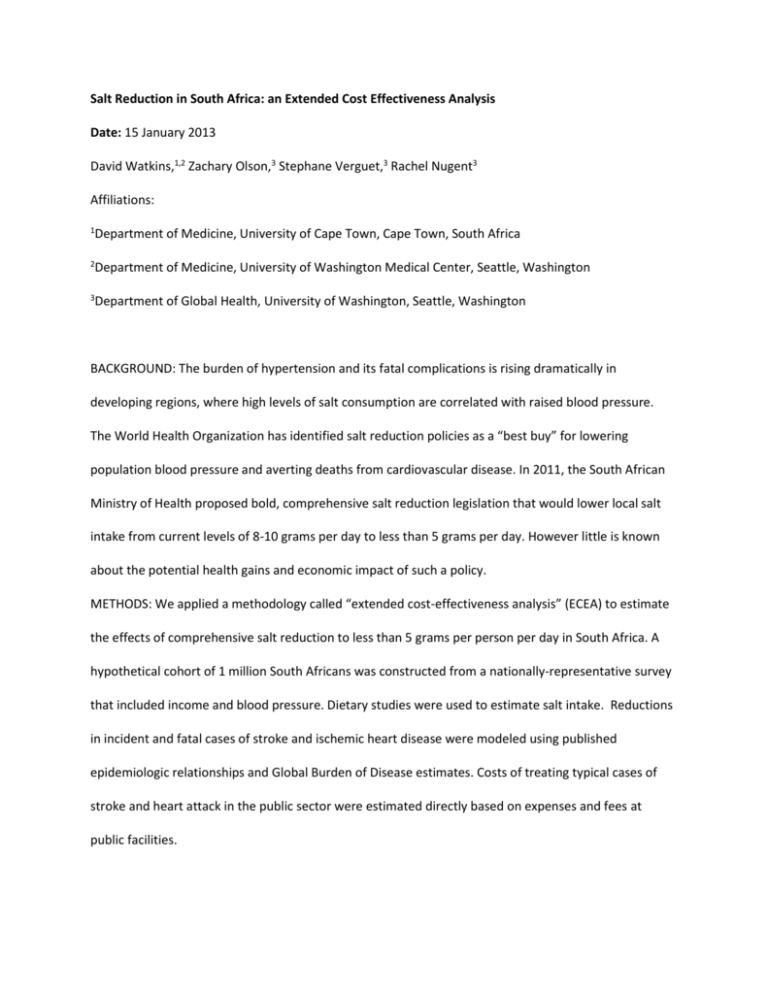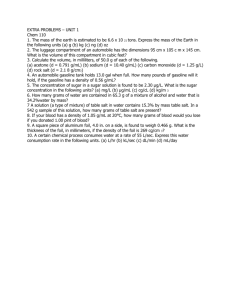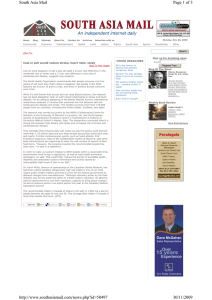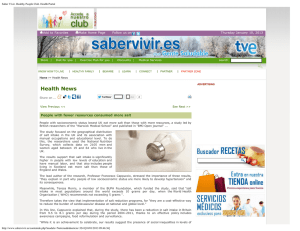Salt Reduction in South Africa
advertisement

Salt Reduction in South Africa: an Extended Cost Effectiveness Analysis Date: 15 January 2013 David Watkins,1,2 Zachary Olson,3 Stephane Verguet,3 Rachel Nugent3 Affiliations: 1 Department of Medicine, University of Cape Town, Cape Town, South Africa 2 Department of Medicine, University of Washington Medical Center, Seattle, Washington 3 Department of Global Health, University of Washington, Seattle, Washington BACKGROUND: The burden of hypertension and its fatal complications is rising dramatically in developing regions, where high levels of salt consumption are correlated with raised blood pressure. The World Health Organization has identified salt reduction policies as a “best buy” for lowering population blood pressure and averting deaths from cardiovascular disease. In 2011, the South African Ministry of Health proposed bold, comprehensive salt reduction legislation that would lower local salt intake from current levels of 8-10 grams per day to less than 5 grams per day. However little is known about the potential health gains and economic impact of such a policy. METHODS: We applied a methodology called “extended cost-effectiveness analysis” (ECEA) to estimate the effects of comprehensive salt reduction to less than 5 grams per person per day in South Africa. A hypothetical cohort of 1 million South Africans was constructed from a nationally-representative survey that included income and blood pressure. Dietary studies were used to estimate salt intake. Reductions in incident and fatal cases of stroke and ischemic heart disease were modeled using published epidemiologic relationships and Global Burden of Disease estimates. Costs of treating typical cases of stroke and heart attack in the public sector were estimated directly based on expenses and fees at public facilities. RESULTS: Lowering population sodium consumption to 5 grams per day resulted in 218 fewer strokes and 136 fewer heart attacks over 1 year in the cohort, with relatively more health gains being seen in the middle income quintiles compared to the richest and poorest. Total private expenditures averted were 1.3 million South African rands, with most of the financial risk protection being afforded to the highest earners. In terms of catastrophic expenditures, defined in South Africa as healthcare costs greater than 10 percent of annual income, two cases of catastrophic stroke expenditure and twenty cases of catastrophic ischemic heart disease expenditure were averted, again, mostly in higher-income individuals. The results were very sensitive to the price of medications and advanced interventions for cardiovascular disease and the progressive fee structure of the South African public sector. CONCLUSIONS: Compared to current diet and blood pressure patterns, a comprehensive dietary salt reduction program in South Africa could avert several thousand deaths across the population from cardiovascular disease and save several million rand each year. Future work will estimate additional reductions in chronic renal disease and hypertensive heart failure and model the financial impact for individuals seeking care in the private sector.











